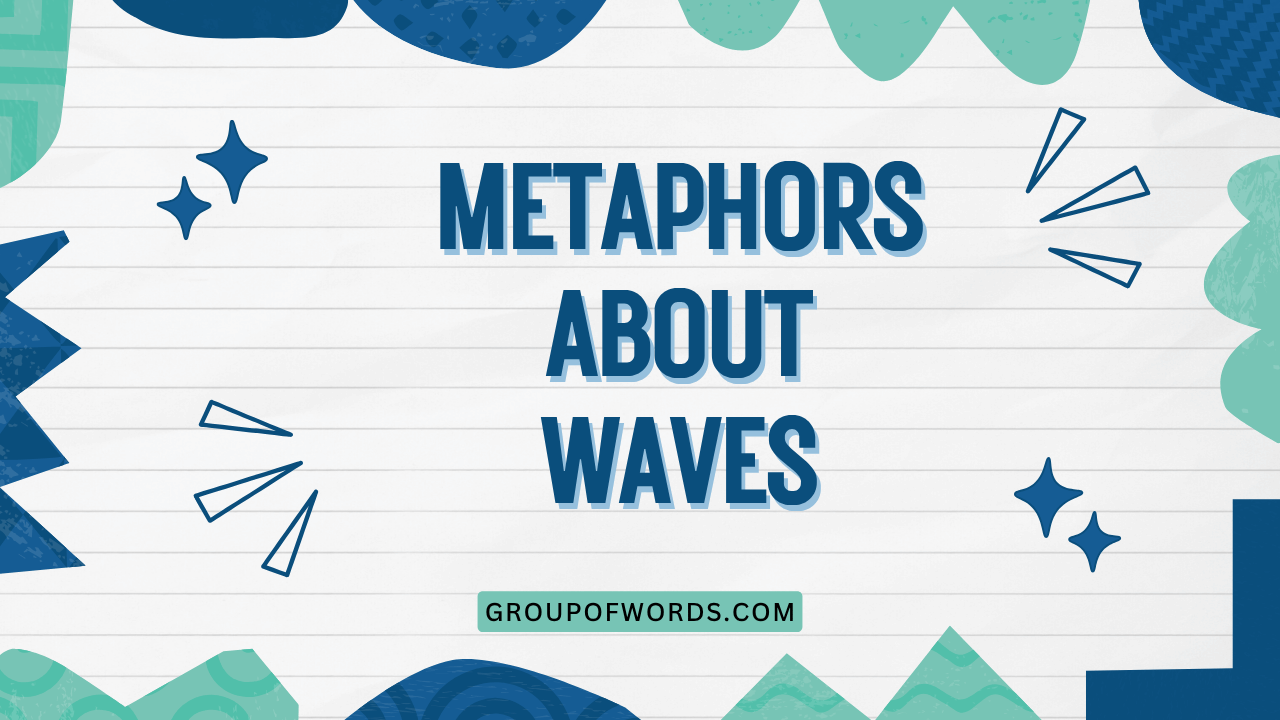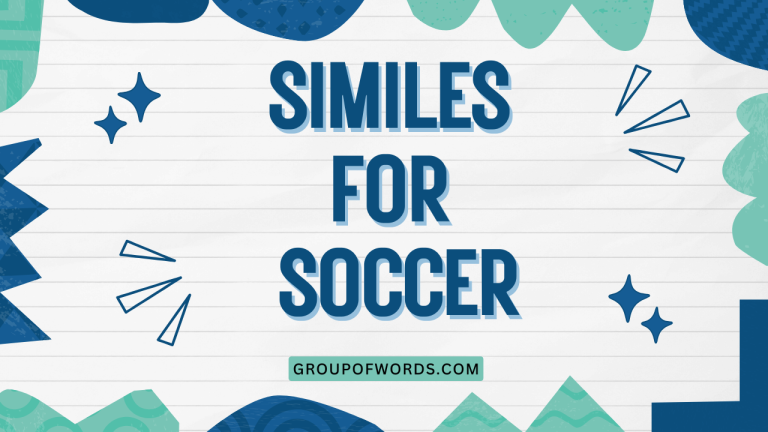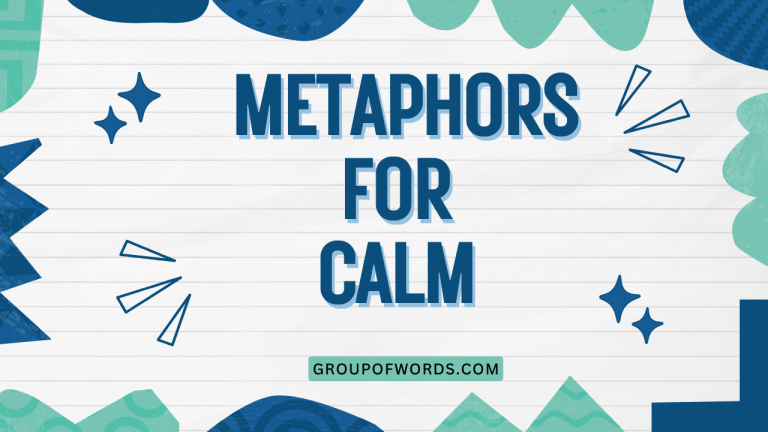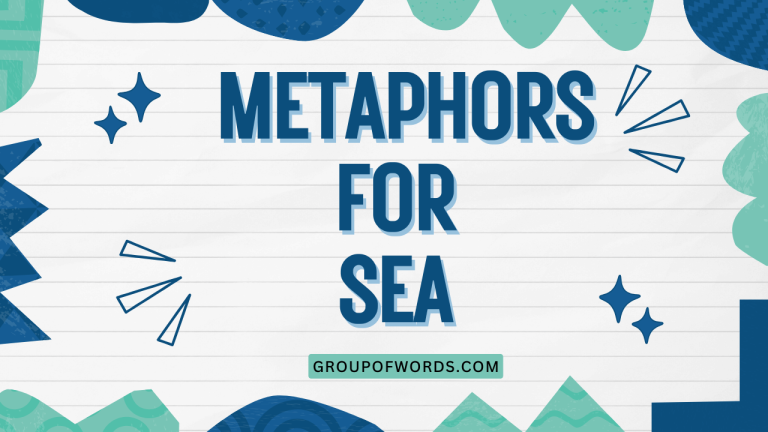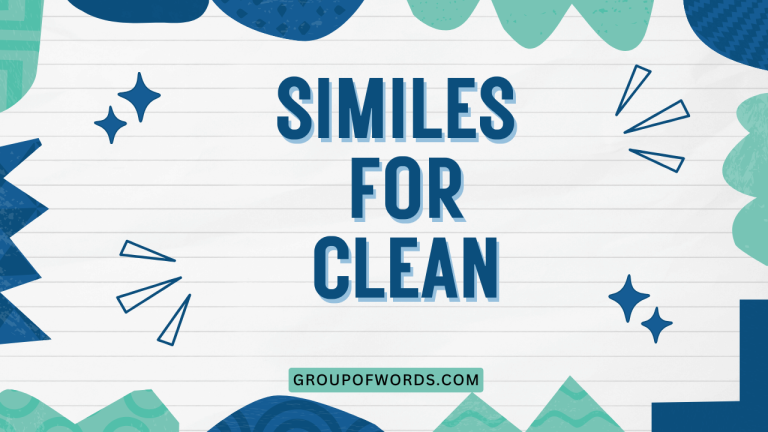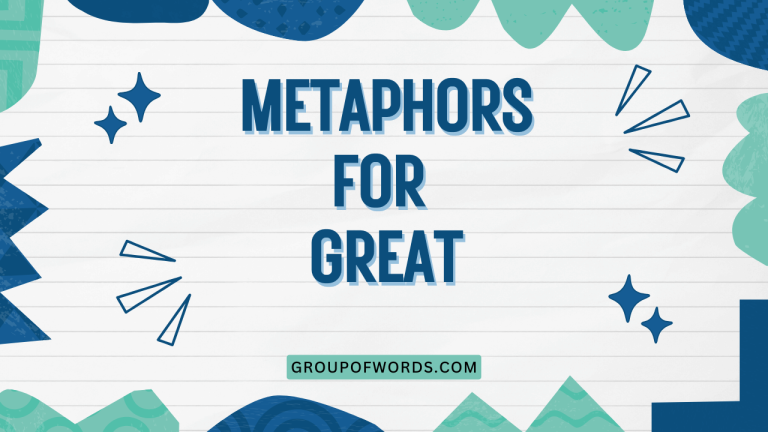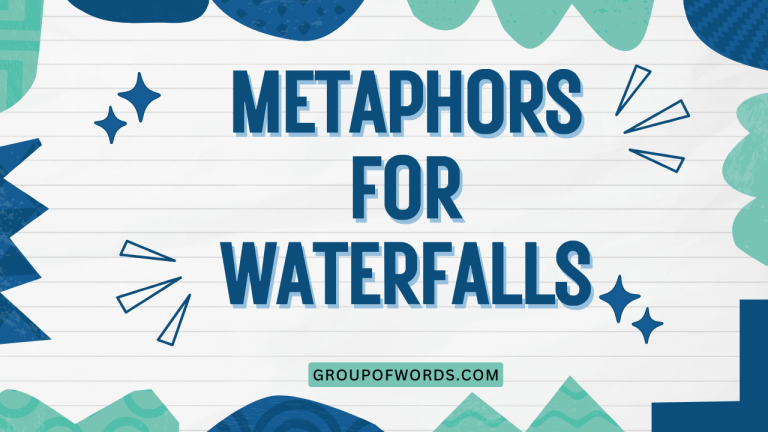Riding the Wave: Mastering Metaphors About Waves in English
Metaphors are powerful tools in the English language, allowing us to understand abstract concepts by relating them to more concrete experiences. Among the most evocative and frequently used metaphors are those that draw parallels between life, emotions, and other phenomena and the characteristics of waves.
Understanding these metaphors not only enriches your vocabulary but also enhances your ability to interpret and express nuanced meanings. This article provides a comprehensive guide to metaphors about waves, exploring their definitions, structures, types, usage rules, and common pitfalls.
This guide is designed for English language learners of all levels, from beginners seeking to expand their figurative language skills to advanced speakers aiming to refine their understanding of idiomatic expressions. By the end of this article, you will be equipped with the knowledge and tools to effectively use and interpret metaphors about waves in both written and spoken English.
Get ready to dive in and navigate the depths of this fascinating linguistic phenomenon!
Definition of Metaphors About Waves
A metaphor is a figure of speech that directly compares two unlike things without using “like” or “as.” It asserts that one thing *is* another, implying a similarity or shared characteristic. Metaphors about waves utilize the properties and behaviors of ocean waves – their ebb and flow, their power and fragility, their predictability, and their unpredictability – to describe other, often abstract, concepts.
These metaphors can be used to describe emotions, life experiences, social trends, and more.
The function of a wave metaphor is to provide a vivid and relatable image that helps the listener or reader understand a complex idea. By drawing on the universally understood experience of observing waves, these metaphors create a powerful connection and enhance communication.
Wave metaphors are particularly effective in conveying the cyclical nature of events, the intensity of feelings, and the challenges of navigating life’s ups and downs.
Wave metaphors are found in a wide range of contexts, from literature and poetry to everyday conversation and business communication. They are used to add depth and color to language, making it more engaging and memorable.
The effectiveness of a wave metaphor lies in its ability to evoke a strong emotional response and create a shared understanding between the speaker and the audience.
Structural Breakdown of Wave Metaphors
The structure of a wave metaphor typically involves identifying a key characteristic of a wave and applying it to the concept being described. Common characteristics include:
- Crest: The highest point of the wave, often representing a peak experience or intense emotion.
- Trough: The lowest point between two waves, symbolizing a low point, setback, or period of sadness.
- Ebb and Flow: The cyclical movement of waves, representing the fluctuations in emotions, fortune, or popularity.
- Momentum: The force and speed of a wave, indicating the drive, energy, or progress of an endeavor.
- Surface: The top of the wave. In metaphors, this can represent what is seen on the surface of a situation.
- Undercurrent: The unseen force beneath the surface, often representing hidden influences or underlying emotions.
- Breaking: The point where a wave collapses, symbolizing a failure, disappointment, or sudden change.
The general pattern of a wave metaphor can be represented as: X is like a wave in terms of Y, where X is the concept being described, and Y is the characteristic of the wave. However, the “like” is often implied rather than explicitly stated.
For example, instead of saying “Her anger was like a wave crashing over her,” we might say “A wave of anger crashed over her,” directly equating the anger with the wave.
Understanding these structural elements allows you to deconstruct and interpret wave metaphors effectively. It also empowers you to create your own metaphors to express complex ideas in a vivid and engaging way.
Pay attention to how the specific characteristics of waves are used to convey meaning and create a powerful image in the reader’s or listener’s mind.
Types and Categories of Wave Metaphors
Wave metaphors can be broadly categorized based on the concepts they are used to describe. Here are some common categories:
Emotional Waves
Emotional wave metaphors are used to describe the intensity and fluctuations of human emotions. These metaphors often highlight the surging and receding nature of feelings, as well as their potential to overwhelm or uplift.
Life’s wave metaphors relate the ups and downs of life to the ebb and flow of the ocean. They often emphasize the challenges of navigating difficult times and the importance of resilience in the face of adversity.Life’s Waves
Social and Political Waves
Social and political wave metaphors are used to describe trends, movements, and shifts in public opinion. These metaphors often highlight the momentum and impact of these forces, as well as their potential to reshape society.
Examples of Wave Metaphors
Here are examples of wave metaphors, organized by category:
Emotional Wave Metaphors
Emotional wave metaphors are frequently used to illustrate the fluctuating nature of feelings and emotional states. The intensity and ebb and flow of emotions are often compared to the powerful and dynamic movement of ocean waves.
The following table provides a detailed look at various examples of emotional wave metaphors, demonstrating how they can be applied in different contexts.
| Metaphor | Explanation | Example Sentence |
|---|---|---|
| A wave of sadness | Sudden onset of intense sorrow. | A wave of sadness washed over her as she remembered her childhood. |
| Crashing wave of grief | Overwhelming and devastating grief. | The news hit him like a crashing wave of grief, leaving him speechless. |
| Tidal wave of emotion | An enormous and uncontrollable emotional surge. | She was swept away by a tidal wave of emotion during the movie. |
| Wave of anger | Sudden and intense feeling of anger. | A wave of anger surged through him when he saw the damage to his car. |
| Waves of nostalgia | Recurring feelings of longing for the past. | Waves of nostalgia washed over him as he looked through old photographs. |
| A gentle wave of contentment | A mild and pleasant feeling of satisfaction. | A gentle wave of contentment settled over her as she watched the sunset. |
| The ebb and flow of emotions | The natural fluctuation of feelings. | She learned to accept the ebb and flow of emotions in her daily life. |
| Drowning in a sea of emotions | Feeling overwhelmed by intense emotions. | After the argument, he felt like he was drowning in a sea of emotions. |
| Riding the wave of happiness | Enjoying a period of great joy and excitement. | She was riding the wave of happiness after receiving the good news. |
| Submerged by a wave of despair | Feeling completely overcome by hopelessness. | He was submerged by a wave of despair after losing his job. |
| A wave of panic | A sudden and overwhelming feeling of fear. | A wave of panic washed over her when she realized she was lost. |
| Feeling the undertow of sadness | Experiencing a persistent undercurrent of sadness. | Even when she smiled, she could still feel the undertow of sadness. |
| A surge of excitement | A sudden and intense feeling of enthusiasm. | A surge of excitement ran through the crowd as the band took the stage. |
| The crest of joy | The peak of happiness and fulfillment. | She reached the crest of joy when she held her newborn child. |
| The trough of depression | The lowest point of a depressive episode. | He struggled to climb out of the trough of depression. |
| A ripple of anxiety | A slight and subtle feeling of worry. | A ripple of anxiety went through the office when the boss called a meeting. |
| Overcome by a swell of pride | Feeling an overwhelming sense of accomplishment. | He was overcome by a swell of pride as he watched his daughter graduate. |
| A tidal wave of relief | An immense feeling of release from stress or worry. | A tidal wave of relief washed over her when she found her missing keys. |
| Caught in the undertow of grief | Being pulled back into sadness despite trying to move on. | Even years later, she felt caught in the undertow of grief. |
| The waves of emotion subsided | The intensity of feelings gradually decreased. | After a while, the waves of emotion subsided, and she felt calmer. |
| A tsunami of rage | An extreme and destructive outburst of anger. | His words unleashed a tsunami of rage in her. |
| Riding the high of excitement | Enjoying the peak of an exhilarating experience. | They were riding the high of excitement after winning the competition. |
| A wave of disappointment | A sudden feeling of sadness after unmet expectations. | A wave of disappointment hit him when he didn’t get the job. |
| The waters of serenity | A calm and peaceful emotional state. | She found solace in the waters of serenity during her meditation. |
| A deluge of tears | An outpouring of crying. | The sad movie caused a deluge of tears. |
| The undercurrent of fear | A latent or suppressed sense of fear. | There was an undercurrent of fear that was always present. |
Life’s wave metaphors are commonly used to depict the unpredictable and cyclical nature of life experiences. Just as ocean waves have their highs and lows, life presents its own set of challenges and triumphs. The following table illustrates various ways in which life’s journey is compared to the ebb and flow of waves, providing insights into the human experience.Life’s Wave Metaphors
Metaphor
Explanation
Example Sentence
Riding the waves of life
Navigating the ups and downs of life’s journey.
We must learn to ride the waves of life with grace and resilience.
Life’s turbulent waters
The difficult and challenging aspects of life.
She had to navigate life’s turbulent waters after losing her job.
A sea of opportunities
A vast and abundant array of possibilities.
The city offered a sea of opportunities for young entrepreneurs.
Adrift in a sea of uncertainty
Feeling lost and without direction in life.
He felt adrift in a sea of uncertainty after graduating from college.
Sailing through life’s journey
Moving forward steadily despite challenges.
They were sailing through life’s journey, hand in hand.
Navigating the currents of life
Making decisions and choices to guide one’s path.
She learned to navigate the currents of life with wisdom and foresight.
Drowning in responsibilities
Feeling overwhelmed by obligations and duties.
He felt like he was drowning in responsibilities at work and at home.
The tide of fortune turns
Changes in luck or circumstances, for better or worse.
After years of hardship, the tide of fortune finally turned in his favor.
A rising tide lifts all boats
When overall conditions improve, everyone benefits.
The new economic policy aims to create a rising tide that lifts all boats.
Weathering the storm of adversity
Enduring and overcoming difficult times.
They weathered the storm of adversity with courage and determination.
The calm after the storm
The peaceful period following a difficult experience.
After the crisis, there was a sense of calm after the storm.
A ripple effect
The far-reaching consequences of an action or event.
Her kindness had a ripple effect on everyone she met.
Making waves
Causing a significant impact or disturbance.
His innovative ideas were making waves in the industry.
Against the tide
Opposing the prevailing trend or popular opinion.
She was swimming against the tide in her fight for equality.
A sea change
A profound and transformative shift.
The company underwent a sea change in its business strategy.
In deep waters
Facing serious trouble or difficulty.
He found himself in deep waters after making a bad investment.
Keeping one’s head above water
Managing to survive or cope with difficult circumstances.
She was struggling to keep her head above water financially.
Smooth sailing
An easy and trouble-free journey or experience.
After the initial challenges, it was smooth sailing for the project.
Treading water
Making little or no progress.
They were just treading water, unable to move forward with their plans.
The crest of success
The peak of achievement and recognition.
She reached the crest of success after years of hard work.
A wave of change
A significant shift or transformation.
A wave of change swept through the organization.
The undertow of regret
A lingering and persistent feeling of remorse.
He felt the undertow of regret for his past mistakes.
The ebb and flow of relationships
The natural fluctuations in the dynamics of interpersonal connections.
Understanding the ebb and flow of relationships is crucial for maintaining them.
The tide turns
A significant shift in circumstances or fortunes.
After a period of decline, the tide turned for the small business.
Finding one’s sea legs
Becoming accustomed to a new situation or environment.
It took him a while to find his sea legs in his new role.
Social and Political Wave Metaphors
Social and political wave metaphors are powerful tools for describing trends, movements, and shifts in public opinion. By comparing these phenomena to the dynamic behavior of ocean waves, speakers and writers can convey the momentum, impact, and potential consequences of these forces.
The following table provides a variety of examples, illustrating how wave metaphors are used to analyze and comment on social and political developments.
| Metaphor | Explanation | Example Sentence |
|---|---|---|
| A wave of protest | A surge in public demonstrations or opposition. | A wave of protest swept across the country in response to the new law. |
| Riding a wave of popularity | Enjoying a period of widespread support or approval. | The politician was riding a wave of popularity after his successful campaign. |
| A political tsunami | A massive and transformative political shift. | The election results were described as a political tsunami. |
| The rising tide of nationalism | An increase in nationalistic sentiment. | There is a rising tide of nationalism in many parts of the world. |
| A wave of innovation | A period of rapid technological or creative advancement. | The tech industry is experiencing a wave of innovation. |
| The undercurrent of discontent | A hidden or suppressed feeling of dissatisfaction. | There was an undercurrent of discontent among the workers. |
| Making waves in the industry | Causing a significant impact or disruption. | The new startup is making waves in the industry with its innovative product. |
| A tidal wave of support | Overwhelmingly strong support. | The charity received a tidal wave of support after the disaster. |
| The ebb and flow of public opinion | Fluctuations in public sentiment over time. | The ebb and flow of public opinion can be unpredictable. |
| A wave of reform | A period of significant changes and improvements. | The government implemented a wave of reform to address corruption. |
| Swimming against the tide of public opinion | Opposing the prevailing sentiment of the majority. | The activist was swimming against the tide of public opinion. |
| A groundswell of support | A growing and widespread feeling of support. | There was a groundswell of support for the new initiative. |
| A ripple effect of the economic crisis | The far-reaching consequences of an economic downturn. | The economic crisis had a ripple effect on many industries. |
| A sea of faces | A large crowd of people. | The speaker addressed a sea of faces at the rally. |
| The tide of history | The broad direction and movement of historical events. | They believed they were on the right side of the tide of history. |
| A wave of immigration | A significant influx of people from other countries. | The country experienced a wave of immigration in the early 20th century. |
| Riding the crest of a social movement | Being at the forefront of a popular social cause. | She was riding the crest of a social movement advocating for change. |
| A deluge of criticism | An overwhelming amount of negative feedback. | The company faced a deluge of criticism after the product recall. |
| The calm before the storm in politics | A deceptive period of quiet before major upheavals. | It was the calm before the storm in politics, with major changes on the horizon. |
| A surge in voter turnout | A significant increase in the number of people voting. | There was a surge in voter turnout during the election. |
| The undertow of economic inequality | The hidden forces that maintain economic disparities. | The undertow of economic inequality continues to challenge social progress. |
| A wave of censorship | A period of increased restrictions on freedom of expression. | The country experienced a wave of censorship under the new regime. |
| The swelling tide of globalization | The increasing interconnectedness of the world. | The swelling tide of globalization continues to reshape economies. |
| A cascade of policy changes | A series of rapid and interconnected policy adjustments. | The new administration introduced a cascade of policy changes. |
| The high tide of cultural influence | The peak of a culture’s impact on other societies. | The high tide of cultural influence from Europe has shaped many countries. |
Usage Rules for Wave Metaphors
Using wave metaphors effectively requires attention to several key rules:
- Clarity: Ensure the metaphor is easily understood and relevant to the context. Avoid obscure or confusing comparisons.
- Consistency: Maintain consistency in the image being conveyed. Don’t mix wave metaphors with other unrelated metaphors.
- Appropriateness: Choose metaphors that are appropriate for the tone and audience. Avoid overly dramatic or cliché metaphors in formal settings.
- Originality: Strive for fresh and original metaphors that capture the reader’s attention. Avoid overused expressions.
Exceptions to these rules may occur in creative writing, where unconventional or experimental metaphors can be used for artistic effect. However, in most contexts, it is important to adhere to these guidelines to ensure clear and effective communication.
Pay attention to the connotations of the wave imagery. Is the wave calm and gentle, or is it a powerful and destructive force?
The choice of imagery will significantly impact the meaning and emotional impact of your metaphor.
Common Mistakes When Using Wave Metaphors
Here are some common mistakes to avoid when using wave metaphors:
- Mixing Metaphors: Combining wave metaphors with other unrelated images can create confusion.
- Overusing Clichés: Relying on overused expressions can make your writing sound unoriginal.
- Inappropriate Tone: Using overly dramatic metaphors in formal settings can be inappropriate.
- Lack of Clarity: Using obscure or confusing metaphors can hinder understanding.
| Incorrect | Correct | Explanation |
|---|---|---|
| The project was a rollercoaster of waves. | The project was a rollercoaster ride. OR The project faced a series of waves of challenges. | Mixing “rollercoaster” and “waves” creates a confusing image. |
| He was drowning in a sea of troubles. (Cliché) | He was overwhelmed by his responsibilities. | Avoid overused expressions that lack originality. |
| The company is riding a tsunami of success! (In a serious business report) | The company is experiencing a period of significant growth. | “Tsunami” is too dramatic for a formal business context. |
| Her emotions were like a purple wave of sadness. | A wave of sadness washed over her. | “Purple wave” is an unusual and potentially confusing image. |
Identify the sentences that contain wave metaphors. Complete the following sentences using an appropriate wave metaphor. Explain the meaning of the wave metaphor in each sentence.
Practice Exercises
Exercise 1: Identifying Wave Metaphors
Question
Answer
1. The news hit him hard.
No
2. A wave of nostalgia swept over her as she looked at the old photos.
Yes
3. The stock market crashed.
No
4. He was drowning in paperwork.
Yes
5. The company is experiencing rapid growth.
No
6. A wave of protest erupted in the city.
Yes
7. She felt a surge of excitement.
Yes
8. The project was completed on time.
No
9. He was swimming against the tide.
Yes
10. The economy is recovering slowly.
No
Exercise 2: Using Wave Metaphors in Sentences
Question
Answer
1. After the scandal, a ______ of criticism rained down on the politician.
deluge
2. The company is ______ of innovation.
riding a wave
3. He felt ______ of sadness after the breakup.
a wave
4. The election results caused ______.
a political tsunami
5. She was ______ of responsibilities.
drowning in a sea
6. The new law sparked ______ across the country.
a wave of protest
7. He is ______ in the industry with his new invention.
making waves
8. They had to ______ of life.
ride the waves
9. The project faced ______.
turbulent waters
10. She felt ______ as she remembered her childhood.
waves of nostalgia
Exercise 3: Interpreting Wave Metaphors
Question
Answer
1. The rising tide of globalization has transformed the world economy.
The increasing interconnectedness of countries is having a profound impact on global commerce.
2. He was caught in the undertow of grief after losing his father.
He was struggling to overcome the persistent sadness and pain caused by his father’s death.
3. The company weathered the storm of the recession.
The company survived the difficult economic period.
4. A wave of anger surged through him when he saw the injustice.
He experienced a sudden and intense feeling of anger.
5. She is swimming against the tide of public opinion.
She is opposing the prevailing beliefs of the majority.
6. They are making waves in the scientific community.
They are causing a significant impact and generating attention in the scientific field.
7. He reached the crest of his career after winning the award.
He achieved the highest point of success in his profession.
8. The new policy created a ripple effect throughout the organization.
The new policy had far-reaching consequences on all aspects of the organization.
9. She was adrift in a sea of uncertainty about her future.
She felt lost and without direction regarding her future plans.
10. A tidal wave of emotion washed over her as she watched her daughter graduate.
She experienced an overwhelming surge of feelings as she witnessed her daughter’s graduation.
Advanced Topics in Wave Metaphors
For advanced learners, exploring the nuances and subtleties of wave metaphors can be a rewarding endeavor. This includes analyzing the cultural and historical context in which these metaphors are used, as well as examining their use in literature and rhetoric.
Consider exploring the works of authors who frequently employ wave metaphors and analyzing how they contribute to the overall meaning and impact of their writing.
Another advanced topic is the creation of extended wave metaphors, where the image of the wave is sustained throughout a longer passage of text. This requires careful attention to detail and a consistent use of imagery to create a cohesive and compelling narrative.
Experiment with using wave metaphors to describe complex processes, abstract concepts, or intricate emotional states.
Furthermore, exploring the intersection of wave metaphors with other types of figurative language, such as similes and personification, can enhance your understanding of their expressive potential. Consider how these different literary devices can be combined to create richer and more evocative imagery.
Frequently Asked Questions
- What is the difference between a metaphor and a simile?
A metaphor directly equates two unlike things, stating that one *is* the other (e.g., “Life is a wave”). A simile compares two unlike things using “like” or “as” (e.g., “Life is like a wave”).
- Why are wave metaphors so common?
Waves are a universal and relatable image, representing cyclical patterns, intensity, and the challenges of navigating life’s ups and downs.
- How can I improve my use of wave metaphors?
Practice using wave metaphors in your writing and speaking. Pay attention to how others use them and experiment with different variations.
- Are there any negative connotations associated with wave metaphors?
Yes, wave metaphors can sometimes be used to describe negative experiences, such as being overwhelmed by emotions or facing difficult challenges.
- Can wave metaphors be used in formal writing?
Yes, but it is important to use them judiciously and avoid overly dramatic or cliché expressions.
- How do I avoid mixing metaphors when using wave imagery?
Maintain consistency in the image being conveyed. Avoid introducing unrelated images that can create confusion.
- What are some alternatives to using wave metaphors?
Other metaphors that can be used to describe similar concepts include those related to weather, journeys, and natural cycles.
- How can I identify a wave metaphor in a text?
Look for language that describes emotions, life experiences, or social trends in terms of waves, tides, or other ocean-related phenomena.
Conclusion
Metaphors about waves offer a powerful and evocative way to understand and express complex ideas. By drawing on the universally understood image of ocean waves, these metaphors can convey the intensity of emotions, the challenges of life, and the dynamics of social and political change.
Mastering the use of wave metaphors can significantly enhance your communication skills and add depth and color to your language.
Remember to use these metaphors with clarity, consistency, and appropriateness, and strive for originality in your expressions. By avoiding common mistakes and practicing regularly, you can effectively incorporate wave metaphors into your writing and speaking, enriching your language and connecting with your audience on a deeper level.
So, go ahead and ride the wave of knowledge and creativity, and let your words flow like the ocean!
